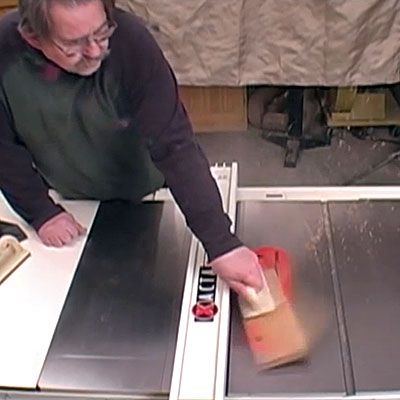
Twenty five years ago, I was a young, self-employed carpenter. I was also an idiot who didn’t always consider the potential consequences of how I was doing the task at hand. One sweaty summer day, I was building cabinets in my shop and I experienced a tablesaw kickback that dragged three fingers through the spinning blade. I was lucky, or I got a good hand surgeon, or both. Although each of those fingers is short some bone, they’re all fully functional, if a little ugly up close.
Anyone who’s experienced a similar event will tell you that it happened unbelievably quickly. You simply can’t react fast enough to save yourself when using a power tool goes south. But don’t believe me. Watch the video below. (Don’t worry – Even though it will make you cringe, it’s not a bloodbath.)
Fine Homebuilding Recommended Products
Fine Homebuilding receives a commission for items purchased through links on this site, including Amazon Associates and other affiliate advertising programs.

8067 All-Weather Flashing Tape

Reliable Crimp Connectors

Handy Heat Gun
























View Comments
Headline: "Man cuts off finger on table saw while making a video of how to not cut your finger off on a table saw"
He is indeed lucky that didn't happen. I was already cringing at his idea of using a push block while creating kickback. Those push blocks have a lot of added grip to the work piece and since your fingers are wrapped around the D-handle they are difficult to quickly release... add that to the fact that he already knew what was going to happen and probably had a much tighter grip than someone who nonchelantly lost control and you have a recipe for disaster.
I much prefer push sticks... keep those phalanges as far away from the blade as possible.
No Video?
Muscle302, there was initially only a small link to the video; I embedded it so you can now watch it above.
Great video. appreciate you taking the time/risk to make this point
Andy, you are indeed lucky that your fingers did not go into the blade. In my opinion, your hand was much too close to the blade to start with. I agree with Dreamcatcher, below: keep your hand a safe distance from the blade. He recommends a push stick, but there are push sticks and there are push sticks.
A simple push stick is not the best solution, because it doesn't give you any control of the front of the board. For a better solution, go to this link at your sister publication, Fine Woodworking (http://www.finewoodworking.com/workshop/article/essential-push-sticks.aspx). The push stick shown is a cross between a push stick and a push block. It keeps your hand above the blade, but the elongated design also gives you more control of the board, allowing you to put downward force on the board, as well as some lateral force toward the fence.
While you're over there, check out this link (http://www.finewoodworking.com/item/106771/tablesaw-techniques) on tablesaw safety by Marc Adams, especially the video on tablesaw safety (Episode 1). I like the length of the push stick he shows toward the end of that video. The one I made is not quite that long, but a little taller to keep my hand farther above the blade, and not as fancy. Unfortunately, you have to be a member to view the tablesaw safety videos.
great
Nice post.
Great job......... keep it up
I thought the danger of kickback was all/only about getting hit with a piece of flying wood. I had no idea it could potentially take your hand into the blade, given the ‘right’ (ie, wrong) circumstances. The sensibility of your making of this video notwithstanding, you certainly made the right call in sharing it. I salute your display of humility for the greater good…certainly mine, at the very least.
Thank you for enlightening me on such an important topic: keeping my fingers and the full function of my hand. I’m installing jamb extensions this very day and will no doubt be thinking of your video each time I turn on the saw.